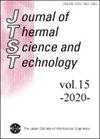A new framework for design and validation of complex heat transfer surfaces based on adjoint optimization and rapid prototyping technologies
IF 1.2
4区 工程技术
Q3 THERMODYNAMICS
引用次数: 5
Abstract
In order to drastically accelerate the development processes of advanced heat exchangers, a new design framework integrating shape optimization, rapid prototyping and experimental validation is proposed. For the optimal design of heat transfer surfaces, a new adjoint-based shape optimization algorithm taking into account unsteady turbulent transport is developed. The present shape optimization algorithm is applied to two di ff erent conventional pin-fin arrays with circular cross sections so as to maximize the analogy factor, i.e., the ratio of heat transfer and pumping power for driving the fluid. The resultant optimal fin shapes are elongated in the streamwise direction and also characterized by bump-like structures formed on the upstream side of the pins. Investigation of numerical results reveals that the pressure drop of the optimal shape is significantly reduced by the suppression of vortex shedding behind the fin, whereas the heat transfer performance is maintained by the extended surface. The optimal shapes are fabricated by a resin-based additive manufacturing technique. A single-blow method allows to evaluate the heat transfer coe ffi cient of low-thermal conductivity materials by measuring the inlet and outlet air temperature only, while the pressure loss is estimated from the pressure measurements at the upstream and downstream of the text matrix by Pit ˆ ot-tubes. As a result, significant improvement of thermal hydraulic performance is experimentally confirmed for the optimal pin-fin arrays as predicted by numerical analyses. The governing equations are non-dimensionalized by a friction velocity based on mean pressure gradient, u (cid:3) (cid:28) , a friction temperature based on uniform heating source, (cid:18) (cid:3) (cid:28) and channel-half width (cid:14) (cid:3) , respectively. The friction-based Reynolds number is set to be Re (cid:28) = u (cid:3) (cid:28) (cid:14) (cid:3) =(cid:23) (cid:3) = 200 (Case 1), 300 (Case 2) which corresponds to an initial bulk Reynolds number of Re b = 500. The Prandtl number is set to Pr = 0 : 71. The fourth and fifth terms in the right-hand-side of Eq. (6) represent the driving force equivalent to a mean pressure gradient and an artificial body force for embedding a solid region in the Cartesian coordinate system by a volume penalization method (Goldstein et al., 1993; Schneider, 2005). Note that ϕ is non-zero only in the solid phase (see, Eq. (4)), so that the damping force acts only in the solid phase in order to eliminate the fluid velocity. Similarly, an isothermal condition on the solid surface is imposed via the last term on the right-hand-side of the energy equation. A periodic boundary condition is applied to the streamwise ( x (cid:0) ) and spanwise ( z (cid:0) ) directions, while the no-slip u = 0 and iso-thermal wall (cid:18) = 0 is applied on the two parallel walls. The grid spacings nondimensionalized by (cid:14) (cid:3) in the x (cid:0) , y (cid:0) , and z (cid:0) directions are ( ∆ x ; ∆ y ; ∆ z ) = (2 : 08 (cid:2) 10 (cid:0) 3 ; 2基于伴随优化和快速成型技术的复杂传热表面设计与验证新框架
为了大大加快先进换热器的发展进程,提出了一种集形状优化、快速成型和实验验证于一体的新型换热器设计框架。针对换热面优化设计问题,提出了一种考虑非定常湍流输运的基于伴随的换热面形状优化算法。将本文的形状优化算法应用于两种不同的圆形截面的传统针鳍阵列,以最大化类比因子,即传热与驱动流体的泵送功率之比。所得到的最佳鳍形在顺流方向上拉长,并且在引脚的上游侧形成凸起状结构。数值计算结果表明,通过抑制翅片后的旋涡脱落,可以显著降低最佳形状的压降,同时通过扩展表面来保持传热性能。最佳形状是由树脂为基础的增材制造技术。单吹法允许仅通过测量入口和出口空气温度来评估低导热材料的传热系数,而压力损失则由Pit - ot管从文本矩阵的上游和下游的压力测量来估计。实验结果表明,优化后的翼片阵列对热工性能的改善效果与数值分析结果一致。控制方程分别由基于平均压力梯度的摩擦速度u (cid:3) (cid:28)、基于均匀热源的摩擦温度(cid:18) (cid:3) (cid:28)和通道半宽度(cid:14) (cid:3)进行无因次化。基于摩擦的雷诺数设置为Re (cid:28) = u (cid:3) (cid:28) (cid:14) (cid:3) =(cid:23) (cid:3) = 200(情况1),300(情况2),对应于初始体积雷诺数Re b = 500。设置普朗特数为Pr = 0: 71。式(6)右侧的第四项和第五项表示采用体积罚法在笛卡尔坐标系中嵌入固体区域的驱动力,相当于平均压力梯度和人工体力(Goldstein et al., 1993;施耐德,2005)。注意,φ仅在固相中为非零(见式(4)),因此阻尼力仅在固相中起作用,以消除流体速度。同样,固体表面的等温条件是通过能量方程右边的最后一项施加的。周期边界条件应用于流向(x (cid:0))和展向(z (cid:0))方向,而无滑移u = 0和等温壁面(cid:18) = 0应用于两个平行壁面。(cid:14) (cid:3)在x (cid:0)、y (cid:0)、z (cid:0)方向上无量纲化的网格间距为(∆x;∆y;∆z) = (2:08 (cid:2) 10 (cid:0) 3;2
本文章由计算机程序翻译,如有差异,请以英文原文为准。
求助全文
约1分钟内获得全文
求助全文
来源期刊
CiteScore
2.30
自引率
8.30%
发文量
0
审稿时长
5 months
期刊介绍:
JTST covers a variety of fields in thermal engineering including heat and mass transfer, thermodynamics, combustion, bio-heat transfer, micro- and macro-scale transport phenomena and practical thermal problems in industrial applications.

 求助内容:
求助内容: 应助结果提醒方式:
应助结果提醒方式:


